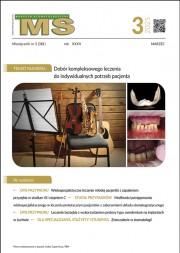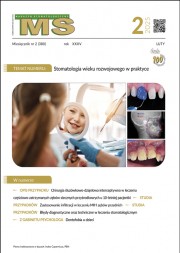Dostęp do tego artykułu jest płatny.
Zapraszamy do zakupu!
Po dokonaniu zakupu artykuł w postaci pliku PDF prześlemy bezpośrednio pod twój adres e-mail.
Leczenie stomatologiczne pacjentów poddanych terapii antyresorpcyjnej – na podstawie piśmiennictwa
Dental treatment of patients undergoing antiresorptive therapy – based on literature
Hanna Sobczak-Jaskow, Robert Sawicki, Barbara Drogoszewska, Barbara Kochańska
Streszczenie
W ostatnich latach wzrasta świadomość w środowisku stomatologów, że dożylna podaż bisfosfonianów, podawanych u chorych onkologicznych, stanowi istotne przeciwwskazanie do leczenia z zakresu chirurgii jamy ustnej. Jednak wciąż pojawia się dużo wątpliwości wśród lekarzy dentystów dotyczących leczenia stomatologicznego u pacjentów poddanych leczeniu antyresorpcyjnemu z powodu osteoporozy. Rola lekarzy dentystów jest niezwykle istotna w profilaktyce MRONJ, dlatego też dentyści powinni być zaznajomieni z algorytmami leczenia pacjentów zakwalifikowanych do terapii antyresorpcyjnej i w jej trakcie.
Abstract
In recent years awareness of the intravenous administering of bisphosphonates in oncological diseases being a contraindication to an oral surgical treatment, has been increasing within the dental community. However there is still doubt among dentists concerning the dental treatment in patients undergoing antiresorptive treatment for osteoporosis. The role of dentists in the prevention of MRONJ is extremely important, hence the dentists should be familiar with the treatment algorithms for qualified patients and during antiresorptive treatment.
Hasła indeksowe: bisfosfoniany, denosumab, martwica, leczenie stomatologiczne, profilaktyka MRONJ
Key words: bisphosphonates, denosumab, necrosis, dental treatment, MRONJ prophylaxis
Piśmiennictwo
- Drake MT, Clarke BL, Khosla S. Bisphosphonates. Mechanism of action and role in clinical practice. Mayo Clin Proc. 2008; 83(9): 1032-1045.
- Marcinowska-Suchowierska E, Czerwiński E, Badurski J i wsp. Leczenie farmakologiczne osteoporozy w Polsce – dostępność, przyczyny braku jego wdrażania. Post Nauk Med. 2015; 28(12): 879-885.
- Drosik K, Krzakowski M, Jarosz J i wsp. Bisfosfoniany w zapobieganiu i kontroli zdarzeń kostnych u chorych z przerzutami nowotworów złośliwych do kości. Onkol Prak Klin 2006; 2(4): 152-164.
- Teślak M, Sobczak H, Ordyniec-Kwaśnica I i wsp. Awareness of medication-related osteonecrosis of the jaws amongst dental professionals in Poland. Appl Sci. 2021; 11(11): 4821.
- Szyszkowska A, Puławska M, Kaczmarek-Borowska B. Bifosfoniany a ryzyko martwicy kości szczęk. Współcz Onkol. 2008; 12(2): 72-76.
- Marx RE, Sawatari Y, Fortin M i wsp. Bisphosphonate-induced exposed bone (osteonecrosis/osteopetrosis) of the jaws. Risk factors, recognition, prevention, and treatment. J Oral Maxillofac Surg. 2005; 63(11): 1567-1575.
- Czyżykowski R, Krakowska M, Potemski P. Bisphosphonates for the treatment of patients with cancer. Oncol Clin Pract. 2017; 13(6): 268-274.
- Hanley DA, Adachi JD, Bell A i wsp. Denosumab: mechanism of action and clinical outcomes. Int J Clin Pract. 2012; 66(12): 1139-1146.
- Eguia A, Bagán-Debón L, Cardona F. Review and update on drugs related to the development of osteonecrosis of the jaw. Med Oral Patol Oral Cir Bucal. 2020; 25(1): e71-e83.
- Ruggiero SL, Dodson TB, Aghaloo T i wsp. American Association of Oral and Maxillofacial Surgeons’ position paper on medication-related osteonecrosis of the jaws – 2022 update. J Oral Maxillofac Surg. 2022; 80(5): 920-943.
- Zajączkowska R, Leppert W, Wordliczek J. Ból kostny u chorych na nowotwory – co wiadomo o mechanizmach jego powstawania? Med Paliat Prakt. 2017; 11(1): 17-23.
- Ottesen C, Schiodt M, Gotfredsen K. Efficacy of a high-dose antiresorptive drug holiday to reduce the risk of medication-related osteonecrosis of the jaw (MRONJ). A systematic review. Heliyon. 2020; 6(4): e03795.
- Di Fede O, Panzarella V, Mauceri R i wsp. The dental management of patients at risk of medication-related osteonecrosis of the jaw. New paradigm of primary prevention. Biomed Res Int. 2018; 2018: 2684924.
- Damm DD, Jones DM. Bisphosphonate-related osteonecrosis of the jaws. A potential alternative to drug holidays. Gen Dent. 2013; 61(5): 33-38.
- Ruggiero SL, Dodson TB, Fantasia J i wsp. American Association of Oral and Maxillofacial Surgeons’ position paper on medication-related osteonecrosis of the jaw – 2014 update. J Oral Maxillofac Surg. 2014; 72(10): 1938-1956.
- Nicolatou-Galitis O, Schiødt M, Mendes RA i wsp. Medication-related osteonecrosis of the jaw. Definition and best practice for prevention, diagnosis, and treatment. Oral Surg Oral Med Oral Pathol Oral Radiol. 2019; 127(2): 117-135.
- Kos M, Kuebler JF, Luczak K i wsp. Bisphosphonate-related osteonecrosis of the jaws. A review of 34 cases and evaluation of risk. J Craniomaxillofac Surg. 2010; 38(4): 255-259.
- Campisi G, Mauceri R, Bertoldo F i wsp. Medication-related osteonecrosis of jaws (MRONJ) prevention and diagnosis. Italian consensus update 2020. Int J Environ Res Public Health. 2020; 17(16): 5998.
- Otto S, Schreyer C, Hafner S i wsp. Bisphosphonate-related osteonecrosis of the jaws – characteristics, risk factors, clinical features, localization and impact on oncological treatment. J Craniomaxillofac Surg. 2012; 40(4): 303-309.
- Kos M. Incidence and risk predictors for osteonecrosis of the jaw in cancer patients treated with intravenous bisphosphonates. Arch Med Sci. 2015; 11(2): 319-324.
- Otto S, Tröltzsch M, Jambrovic V i wsp. Tooth extraction in patients receiving oral or intravenous bisphosphonate administration. A trigger for BRONJ development? J Craniomaxillofac Surg. 2015; 43(6): 847-854.
- Lopes RN, Rabelo GD, Rocha AC i wsp. Surgical therapy for bisphosphonate-related osteonecrosis of the jaw. Six-year experience of a single institution. J Oral Maxillofac Surg. 2015; 73(7): 1288-1295.
- Song M. Dental care for patients taking antiresorptive drugs. A literature review. Restor Dent Endod. 2019; 44(4): e42.
- Kim KM, Rhee Y, Kwon YD i wsp. Medication related osteonecrosis of the jaw. 2015 position statement of the Korean Society for Bone and Mineral Research and the Korean Association of Oral and Maxillofacial Surgeons. J Bone Metab. 2015; 22(4): 151-165.
- Moinzadeh AT, Shemesh H, Neirynck NA i wsp. Bisphosphonates and their clinical implications in endodontic therapy. Int Endod J. 2013; 46(5): 391-398.
- Kaczmarzyk T, Babiuch K, Bołtacz-Rzepkowska E i wsp. Rekomendacje Grupy Roboczej Polskiego Towarzystwa Stomatologicznego i Narodowego Programu Ochrony Antybiotyków w zakresie stosowania antybiotyków w stomatologii. Warszawa: Narodowy Instytut Leków; 2019.
- Sobczak H, Teślak M, Chlebus I i wsp. Leczenie implantologiczne u pacjentów z osteoporozą poddanych terapii z zastosowaniem doustnych bisfosfonianów. Na podstawie piśmiennictwa. Mag Stomatol. 2021; 6: 82-86.
- Borromeo GL, Tsao CE, Darby IB i wsp. A review of the clinical implications of bisphosphonates in dentistry. Aust Dent J. 2011; 56(1): 2-9.















